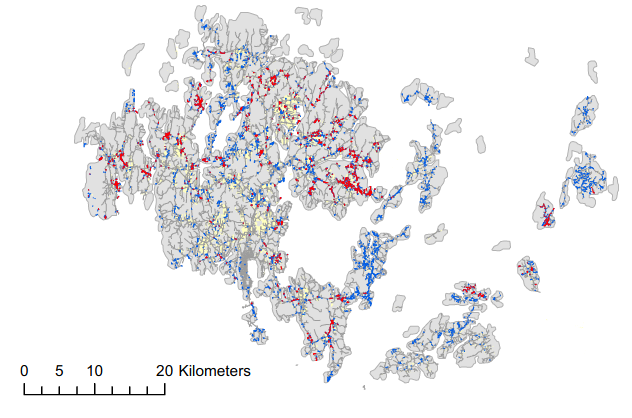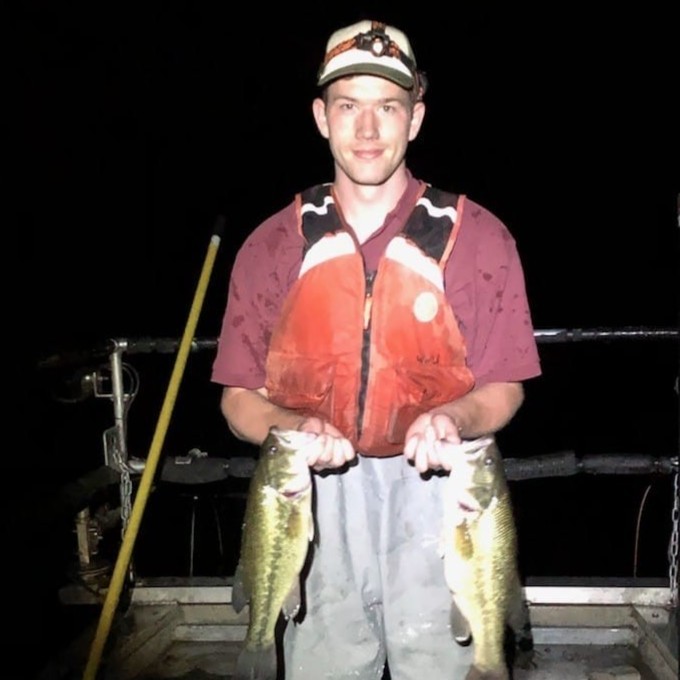class: left, top, inverse, title-slide .title[ # <strong>Metapopulations: Part II</strong> ] .subtitle[ ## <a href="https://eligurarie.github.io/EFB370/">EFB 370: Population Ecology</a> ] .author[ ### .white[**Dr. Elie Gurarie]** ] .date[ ### .white[March 19, 2025] ] --- <style type="text/css"> MathJax.Hub.Config({ tex2jax: { inlineMath: [['$','$'], ['\\(','\\)']], processEscapes: true } }); </style> ## Four metapopulation models .center[ <img src="Metapopulations_PartII_files/figure-html/unnamed-chunk-3-1.png" width="70%" /> With very different predictions! (Nice synthesis - mainly due to Gotelli.) ] --- ## Model predictions: .pull-left[ <img src="Metapopulations_PartII_files/figure-html/unnamed-chunk-4-1.png" width="100%" /> ] .pull-right[ | | External Colonization | Internal Colonization |:----:|:----:|:----: | **Constant Extinction** | `\(p_c \over p_c + p_e\)` | 0 or `\(1 - {p_e / p_c}\)` | **Rescue Effect** | `\(p_c \over p_e\)` or 1 | 0 or 1 <br><br> .red.center[So ... **are metapopulations stable or not!?**] ] --- ## Theory vs. Reality .pull-left[ **Assumptions** - "Instantaneous" (binary) population growth - straight to `\(K\)` - Homogeneous patch quality - Homogeneous growth process - Implicit spatial structure - (all patches affect all others equally) - Deterministic process ] .pull-right[ **Complications** - You can have **none**, **some**, or **lots** in a patch - Unique - `\(K_i\)` - Unique `\(r_i\)` - Neighboring patches are more locally important, some patches are very connected, some are very distant - Stochasticity is very important, esp. for extinction probabilities ] --- .pull-left-60[ ## Which is it!? **It's hard to do metapopulation studies!**  The longest-term, most data-rich study ever ... ] -- .pull-right-40[ leads to somewhat *meh* results  .center[ <img src='images/fritillary_title.png' width='90%'/> ] ] --- ## General principles of metapopulation management .pull-left-70[ Can be challenging because **equilibrium** may or may not exist! But metapopulation will **surely** become extinct if patches are removed ... - ... but **facilitating recolonization** and maintaining **large patches** can help. As many fragments as possible should be preserved... - ... but distances can't be too large, or no recolonization or rescue effect. Properties of the matrix are important: - **corridors** and **stepping stones**. Recolonization has to be observed within a few generations for metapopulations to have a chance. Sizes of patches is important to hedge against demographic stochasticity. ] .pull-right-30[  ] --- class: inverse ### Pseudo guest lecture 1: .red[**New England Cottontail**] .pull-left-30[  Dr. Jonathan Cohen ] .pull-right-70[  ] --- class: inverse ### Pseudo guest lecture 2: .red[**Allegheny Woodrat metapopulation**] .pull-left-30[  Colton Moyer, M.S. ] .pull-right-70[  ] --- ## .darkred[**Question:** How is **poaching** affecting recovery of Pinto Abalone?] .pull-left-70[ > - important cultural / subsistence item for Indigeneous communities on Pacific coast. > - overharvested commercially to **near extinction** > - commercial harvest **banned** in 1990 > - recovering very slowly ... or not at all ] .pull-right-30[  .center[*Haliotis kamtschatkana*] ]  --- ## .darkred[**Question:** How is **poaching** affecting recovery of Pinto Abalone?] .pull-left-50[ .green[ ### .center[Solution: **lots of modeling!**]] ] .pull-right[]  --- .pull-left[ ## Habitat submodel Patchy locations ... looks like **metapopulation**  ] -- .pull-right[ ## Population submodel  .box-yellow[ **all our friends represented:** .pull-left-60[ - Growth rate - `\(R_{max}\)` - Carrying capacity - `\(k\)` - Age-structured fecundity ] .pull-right-40[ - Survival - `\(N_0\)` ] ] ] --- ## Dispersal submodel .pull-left-60[ ] .pull-right-40[ .darkblue[Very typical dispersal **kernel**: `$$\large Pr(A\,to \,B) = \alpha \, e^{- \beta \, d_{AB}}$$` where `\(d_{AB}\)` is distance between `\(A\)` and `\(B\)`. ] <!-- --> ] --- ## Poaching submodel  .center.darkred[Heavy use of **sensitivity analysis** for unknown or difficult to know parameters,] --- ## Abalone results Used: metapopulation .darkblue[**probability of extinction = 0.1**] as threshold, (corresponding to IUCN definition of .darkred[**vulnerable**]). .pull-left-70[  ] .pull-right-30.large[ .box-blue[ Determined that **yes** in nearly ALL modeled scenarios, reasonable estimates of poaching lead to a higher **risk of extinction** for the metapopulation. ] ] --- class: inverse ## .center[Pop Quiz: **Who Else Loves Abalone?**] -- .pull-left[ ### .center[our old friends!]  .center[**NEXT TOPIC: Species Interactions!**] ] -- .pull-right[ For a fascinating deep dive in the interactions & conflicts among **abalone**, **sea otters**, **conservation laws**, and **First Nation stewardship** check out [**this podcast:**](https://www.futureecologies.net/kelpworlds)  ]